Rheumatoid Arthritis: A Comprehensive Literature Review at ECU
VerifiedAdded on 2022/08/31
|11
|2919
|19
Literature Review
AI Summary
This literature review provides a comprehensive overview of Rheumatoid Arthritis (RA), an autoimmune disease affecting millions. It begins with a summary of the disease, its symptoms, and the goals of treatment. The review then delves into the epidemiology of RA, highlighting its prevalence and impact on various demographics. It explores the pathogenesis of RA, detailing the cellular and molecular mechanisms involved in joint inflammation and damage. The etiology of RA is discussed, including genetic and environmental factors. The review further covers the pathophysiology, diagnosis, and assessment of disease activity, including the use of various scoring systems and biomarkers. Finally, the literature review explores the treatment options for RA, including lifestyle modifications, medications, and surgical procedures, along with the role of pharmacists. This literature review offers valuable insights into the multifaceted nature of RA, providing a foundation for understanding its complexities and current management strategies.

Running Head : LITERATURE REVIEW
Literature Review
Name of the Student
Name of the University
Author Note
Literature Review
Name of the Student
Name of the University
Author Note
Paraphrase This Document
Need a fresh take? Get an instant paraphrase of this document with our AI Paraphraser
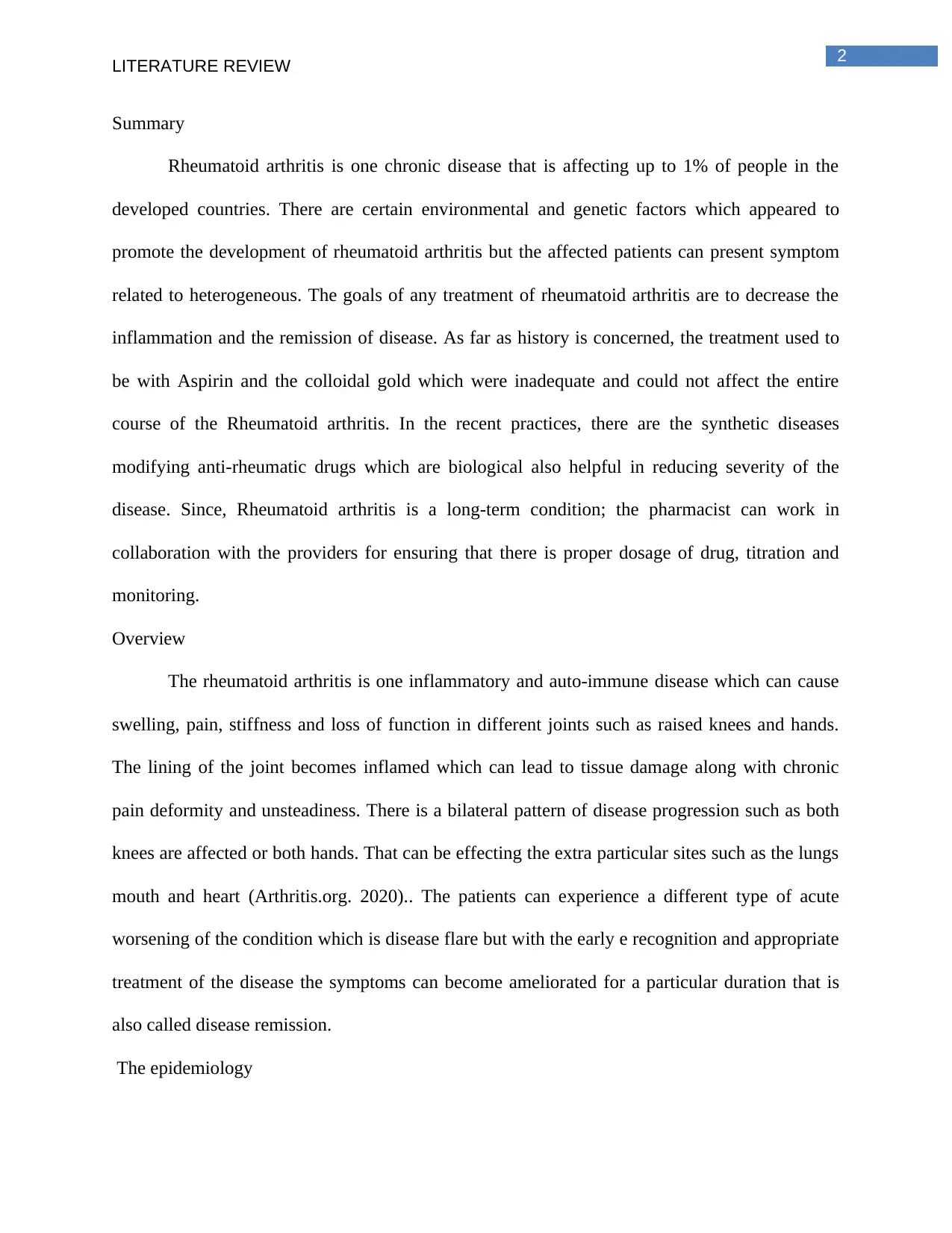
2
LITERATURE REVIEW
Summary
Rheumatoid arthritis is one chronic disease that is affecting up to 1% of people in the
developed countries. There are certain environmental and genetic factors which appeared to
promote the development of rheumatoid arthritis but the affected patients can present symptom
related to heterogeneous. The goals of any treatment of rheumatoid arthritis are to decrease the
inflammation and the remission of disease. As far as history is concerned, the treatment used to
be with Aspirin and the colloidal gold which were inadequate and could not affect the entire
course of the Rheumatoid arthritis. In the recent practices, there are the synthetic diseases
modifying anti-rheumatic drugs which are biological also helpful in reducing severity of the
disease. Since, Rheumatoid arthritis is a long-term condition; the pharmacist can work in
collaboration with the providers for ensuring that there is proper dosage of drug, titration and
monitoring.
Overview
The rheumatoid arthritis is one inflammatory and auto-immune disease which can cause
swelling, pain, stiffness and loss of function in different joints such as raised knees and hands.
The lining of the joint becomes inflamed which can lead to tissue damage along with chronic
pain deformity and unsteadiness. There is a bilateral pattern of disease progression such as both
knees are affected or both hands. That can be effecting the extra particular sites such as the lungs
mouth and heart (Arthritis.org. 2020).. The patients can experience a different type of acute
worsening of the condition which is disease flare but with the early e recognition and appropriate
treatment of the disease the symptoms can become ameliorated for a particular duration that is
also called disease remission.
The epidemiology
LITERATURE REVIEW
Summary
Rheumatoid arthritis is one chronic disease that is affecting up to 1% of people in the
developed countries. There are certain environmental and genetic factors which appeared to
promote the development of rheumatoid arthritis but the affected patients can present symptom
related to heterogeneous. The goals of any treatment of rheumatoid arthritis are to decrease the
inflammation and the remission of disease. As far as history is concerned, the treatment used to
be with Aspirin and the colloidal gold which were inadequate and could not affect the entire
course of the Rheumatoid arthritis. In the recent practices, there are the synthetic diseases
modifying anti-rheumatic drugs which are biological also helpful in reducing severity of the
disease. Since, Rheumatoid arthritis is a long-term condition; the pharmacist can work in
collaboration with the providers for ensuring that there is proper dosage of drug, titration and
monitoring.
Overview
The rheumatoid arthritis is one inflammatory and auto-immune disease which can cause
swelling, pain, stiffness and loss of function in different joints such as raised knees and hands.
The lining of the joint becomes inflamed which can lead to tissue damage along with chronic
pain deformity and unsteadiness. There is a bilateral pattern of disease progression such as both
knees are affected or both hands. That can be effecting the extra particular sites such as the lungs
mouth and heart (Arthritis.org. 2020).. The patients can experience a different type of acute
worsening of the condition which is disease flare but with the early e recognition and appropriate
treatment of the disease the symptoms can become ameliorated for a particular duration that is
also called disease remission.
The epidemiology
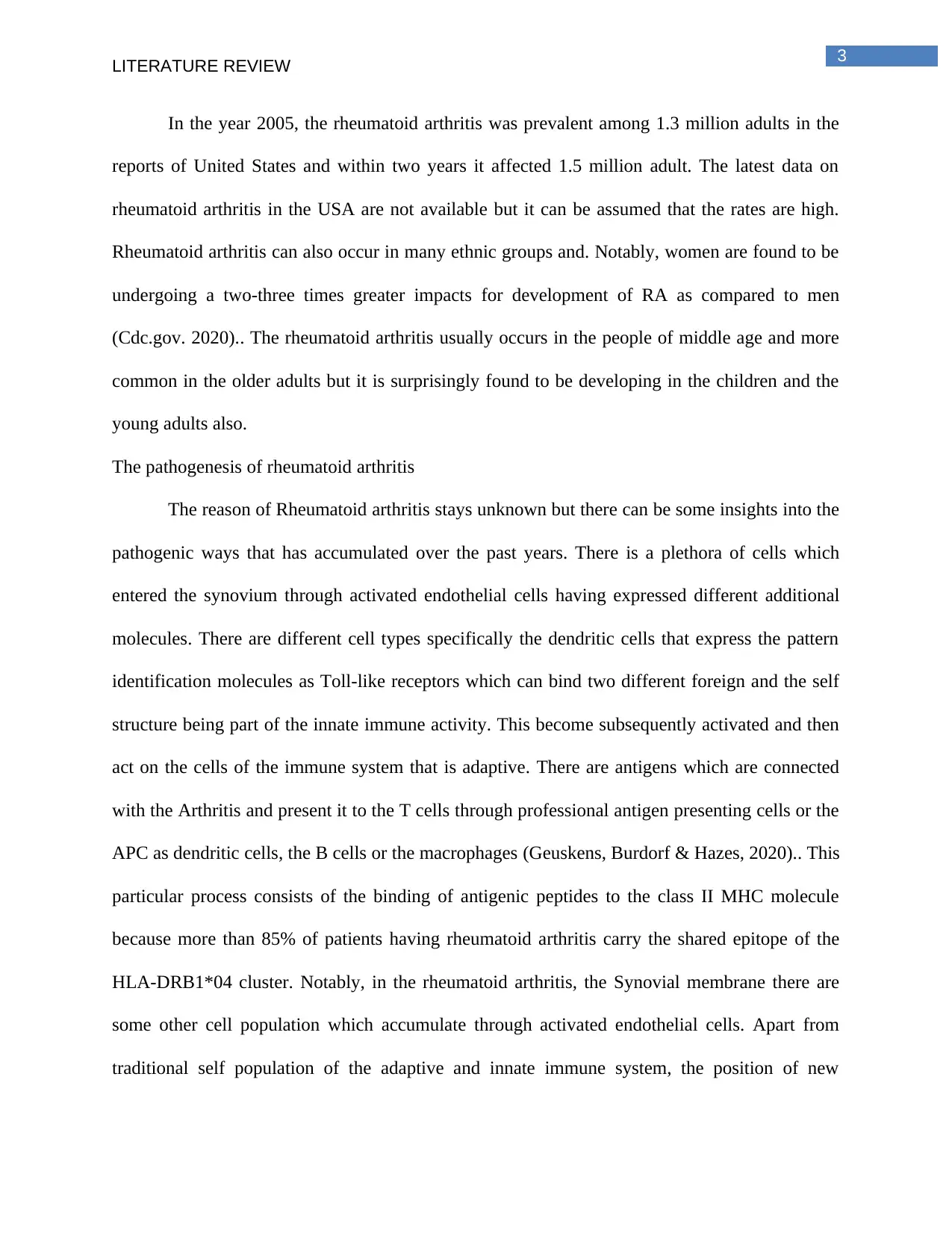
3
LITERATURE REVIEW
In the year 2005, the rheumatoid arthritis was prevalent among 1.3 million adults in the
reports of United States and within two years it affected 1.5 million adult. The latest data on
rheumatoid arthritis in the USA are not available but it can be assumed that the rates are high.
Rheumatoid arthritis can also occur in many ethnic groups and. Notably, women are found to be
undergoing a two-three times greater impacts for development of RA as compared to men
(Cdc.gov. 2020).. The rheumatoid arthritis usually occurs in the people of middle age and more
common in the older adults but it is surprisingly found to be developing in the children and the
young adults also.
The pathogenesis of rheumatoid arthritis
The reason of Rheumatoid arthritis stays unknown but there can be some insights into the
pathogenic ways that has accumulated over the past years. There is a plethora of cells which
entered the synovium through activated endothelial cells having expressed different additional
molecules. There are different cell types specifically the dendritic cells that express the pattern
identification molecules as Toll-like receptors which can bind two different foreign and the self
structure being part of the innate immune activity. This become subsequently activated and then
act on the cells of the immune system that is adaptive. There are antigens which are connected
with the Arthritis and present it to the T cells through professional antigen presenting cells or the
APC as dendritic cells, the B cells or the macrophages (Geuskens, Burdorf & Hazes, 2020).. This
particular process consists of the binding of antigenic peptides to the class II MHC molecule
because more than 85% of patients having rheumatoid arthritis carry the shared epitope of the
HLA-DRB1*04 cluster. Notably, in the rheumatoid arthritis, the Synovial membrane there are
some other cell population which accumulate through activated endothelial cells. Apart from
traditional self population of the adaptive and innate immune system, the position of new
LITERATURE REVIEW
In the year 2005, the rheumatoid arthritis was prevalent among 1.3 million adults in the
reports of United States and within two years it affected 1.5 million adult. The latest data on
rheumatoid arthritis in the USA are not available but it can be assumed that the rates are high.
Rheumatoid arthritis can also occur in many ethnic groups and. Notably, women are found to be
undergoing a two-three times greater impacts for development of RA as compared to men
(Cdc.gov. 2020).. The rheumatoid arthritis usually occurs in the people of middle age and more
common in the older adults but it is surprisingly found to be developing in the children and the
young adults also.
The pathogenesis of rheumatoid arthritis
The reason of Rheumatoid arthritis stays unknown but there can be some insights into the
pathogenic ways that has accumulated over the past years. There is a plethora of cells which
entered the synovium through activated endothelial cells having expressed different additional
molecules. There are different cell types specifically the dendritic cells that express the pattern
identification molecules as Toll-like receptors which can bind two different foreign and the self
structure being part of the innate immune activity. This become subsequently activated and then
act on the cells of the immune system that is adaptive. There are antigens which are connected
with the Arthritis and present it to the T cells through professional antigen presenting cells or the
APC as dendritic cells, the B cells or the macrophages (Geuskens, Burdorf & Hazes, 2020).. This
particular process consists of the binding of antigenic peptides to the class II MHC molecule
because more than 85% of patients having rheumatoid arthritis carry the shared epitope of the
HLA-DRB1*04 cluster. Notably, in the rheumatoid arthritis, the Synovial membrane there are
some other cell population which accumulate through activated endothelial cells. Apart from
traditional self population of the adaptive and innate immune system, the position of new
⊘ This is a preview!⊘
Do you want full access?
Subscribe today to unlock all pages.

Trusted by 1+ million students worldwide
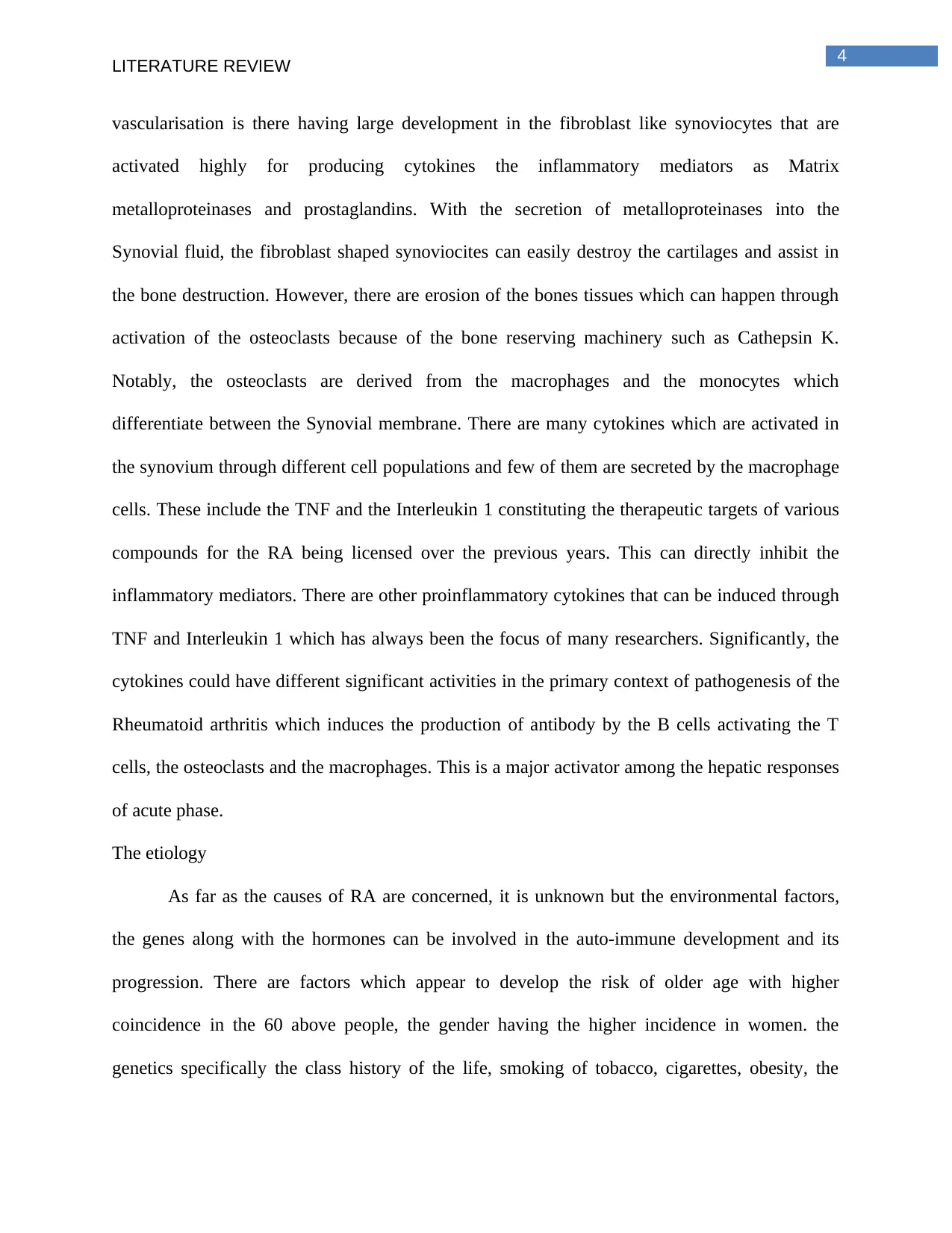
4
LITERATURE REVIEW
vascularisation is there having large development in the fibroblast like synoviocytes that are
activated highly for producing cytokines the inflammatory mediators as Matrix
metalloproteinases and prostaglandins. With the secretion of metalloproteinases into the
Synovial fluid, the fibroblast shaped synoviocites can easily destroy the cartilages and assist in
the bone destruction. However, there are erosion of the bones tissues which can happen through
activation of the osteoclasts because of the bone reserving machinery such as Cathepsin K.
Notably, the osteoclasts are derived from the macrophages and the monocytes which
differentiate between the Synovial membrane. There are many cytokines which are activated in
the synovium through different cell populations and few of them are secreted by the macrophage
cells. These include the TNF and the Interleukin 1 constituting the therapeutic targets of various
compounds for the RA being licensed over the previous years. This can directly inhibit the
inflammatory mediators. There are other proinflammatory cytokines that can be induced through
TNF and Interleukin 1 which has always been the focus of many researchers. Significantly, the
cytokines could have different significant activities in the primary context of pathogenesis of the
Rheumatoid arthritis which induces the production of antibody by the B cells activating the T
cells, the osteoclasts and the macrophages. This is a major activator among the hepatic responses
of acute phase.
The etiology
As far as the causes of RA are concerned, it is unknown but the environmental factors,
the genes along with the hormones can be involved in the auto-immune development and its
progression. There are factors which appear to develop the risk of older age with higher
coincidence in the 60 above people, the gender having the higher incidence in women. the
genetics specifically the class history of the life, smoking of tobacco, cigarettes, obesity, the
LITERATURE REVIEW
vascularisation is there having large development in the fibroblast like synoviocytes that are
activated highly for producing cytokines the inflammatory mediators as Matrix
metalloproteinases and prostaglandins. With the secretion of metalloproteinases into the
Synovial fluid, the fibroblast shaped synoviocites can easily destroy the cartilages and assist in
the bone destruction. However, there are erosion of the bones tissues which can happen through
activation of the osteoclasts because of the bone reserving machinery such as Cathepsin K.
Notably, the osteoclasts are derived from the macrophages and the monocytes which
differentiate between the Synovial membrane. There are many cytokines which are activated in
the synovium through different cell populations and few of them are secreted by the macrophage
cells. These include the TNF and the Interleukin 1 constituting the therapeutic targets of various
compounds for the RA being licensed over the previous years. This can directly inhibit the
inflammatory mediators. There are other proinflammatory cytokines that can be induced through
TNF and Interleukin 1 which has always been the focus of many researchers. Significantly, the
cytokines could have different significant activities in the primary context of pathogenesis of the
Rheumatoid arthritis which induces the production of antibody by the B cells activating the T
cells, the osteoclasts and the macrophages. This is a major activator among the hepatic responses
of acute phase.
The etiology
As far as the causes of RA are concerned, it is unknown but the environmental factors,
the genes along with the hormones can be involved in the auto-immune development and its
progression. There are factors which appear to develop the risk of older age with higher
coincidence in the 60 above people, the gender having the higher incidence in women. the
genetics specifically the class history of the life, smoking of tobacco, cigarettes, obesity, the
Paraphrase This Document
Need a fresh take? Get an instant paraphrase of this document with our AI Paraphraser
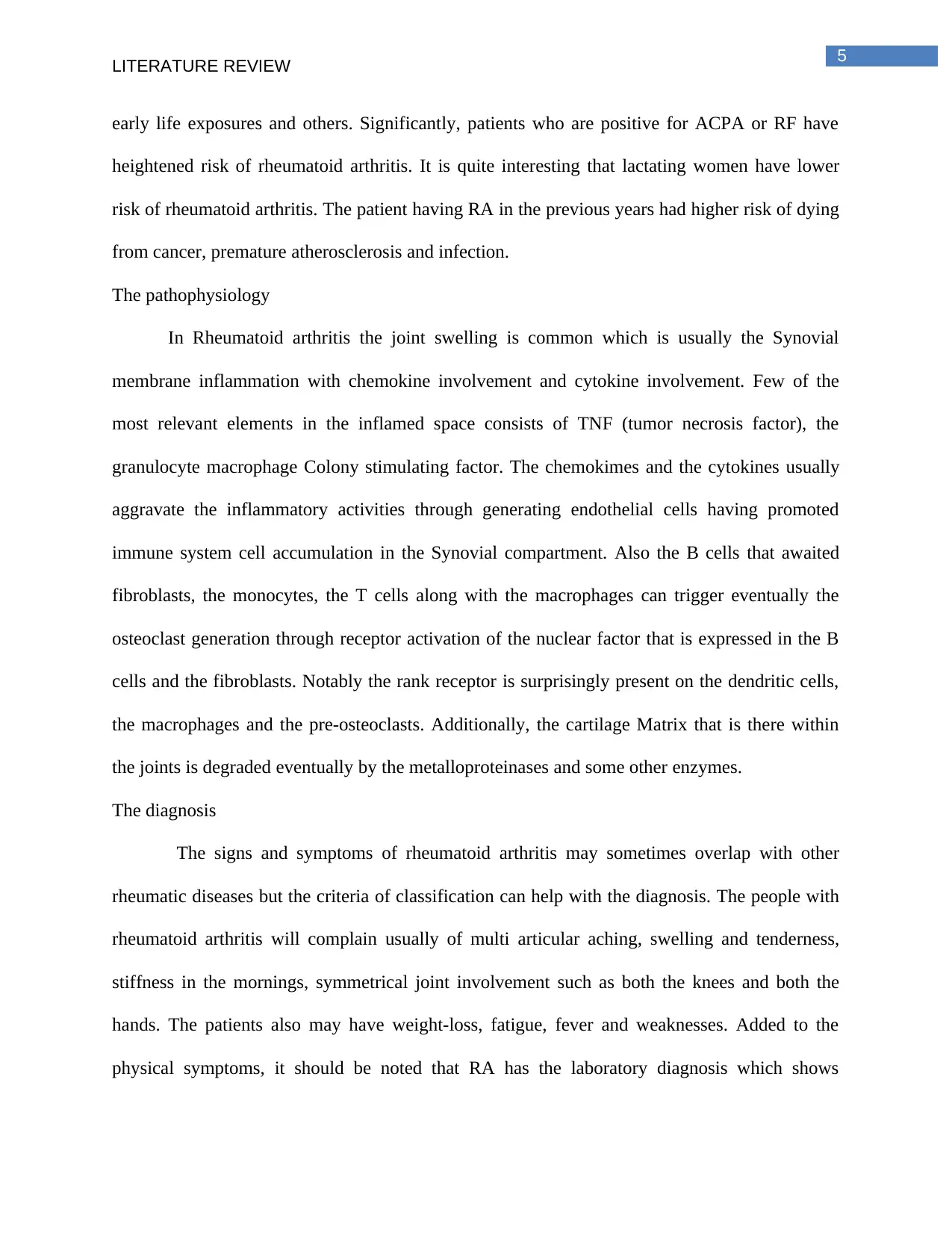
5
LITERATURE REVIEW
early life exposures and others. Significantly, patients who are positive for ACPA or RF have
heightened risk of rheumatoid arthritis. It is quite interesting that lactating women have lower
risk of rheumatoid arthritis. The patient having RA in the previous years had higher risk of dying
from cancer, premature atherosclerosis and infection.
The pathophysiology
In Rheumatoid arthritis the joint swelling is common which is usually the Synovial
membrane inflammation with chemokine involvement and cytokine involvement. Few of the
most relevant elements in the inflamed space consists of TNF (tumor necrosis factor), the
granulocyte macrophage Colony stimulating factor. The chemokimes and the cytokines usually
aggravate the inflammatory activities through generating endothelial cells having promoted
immune system cell accumulation in the Synovial compartment. Also the B cells that awaited
fibroblasts, the monocytes, the T cells along with the macrophages can trigger eventually the
osteoclast generation through receptor activation of the nuclear factor that is expressed in the B
cells and the fibroblasts. Notably the rank receptor is surprisingly present on the dendritic cells,
the macrophages and the pre-osteoclasts. Additionally, the cartilage Matrix that is there within
the joints is degraded eventually by the metalloproteinases and some other enzymes.
The diagnosis
The signs and symptoms of rheumatoid arthritis may sometimes overlap with other
rheumatic diseases but the criteria of classification can help with the diagnosis. The people with
rheumatoid arthritis will complain usually of multi articular aching, swelling and tenderness,
stiffness in the mornings, symmetrical joint involvement such as both the knees and both the
hands. The patients also may have weight-loss, fatigue, fever and weaknesses. Added to the
physical symptoms, it should be noted that RA has the laboratory diagnosis which shows
LITERATURE REVIEW
early life exposures and others. Significantly, patients who are positive for ACPA or RF have
heightened risk of rheumatoid arthritis. It is quite interesting that lactating women have lower
risk of rheumatoid arthritis. The patient having RA in the previous years had higher risk of dying
from cancer, premature atherosclerosis and infection.
The pathophysiology
In Rheumatoid arthritis the joint swelling is common which is usually the Synovial
membrane inflammation with chemokine involvement and cytokine involvement. Few of the
most relevant elements in the inflamed space consists of TNF (tumor necrosis factor), the
granulocyte macrophage Colony stimulating factor. The chemokimes and the cytokines usually
aggravate the inflammatory activities through generating endothelial cells having promoted
immune system cell accumulation in the Synovial compartment. Also the B cells that awaited
fibroblasts, the monocytes, the T cells along with the macrophages can trigger eventually the
osteoclast generation through receptor activation of the nuclear factor that is expressed in the B
cells and the fibroblasts. Notably the rank receptor is surprisingly present on the dendritic cells,
the macrophages and the pre-osteoclasts. Additionally, the cartilage Matrix that is there within
the joints is degraded eventually by the metalloproteinases and some other enzymes.
The diagnosis
The signs and symptoms of rheumatoid arthritis may sometimes overlap with other
rheumatic diseases but the criteria of classification can help with the diagnosis. The people with
rheumatoid arthritis will complain usually of multi articular aching, swelling and tenderness,
stiffness in the mornings, symmetrical joint involvement such as both the knees and both the
hands. The patients also may have weight-loss, fatigue, fever and weaknesses. Added to the
physical symptoms, it should be noted that RA has the laboratory diagnosis which shows
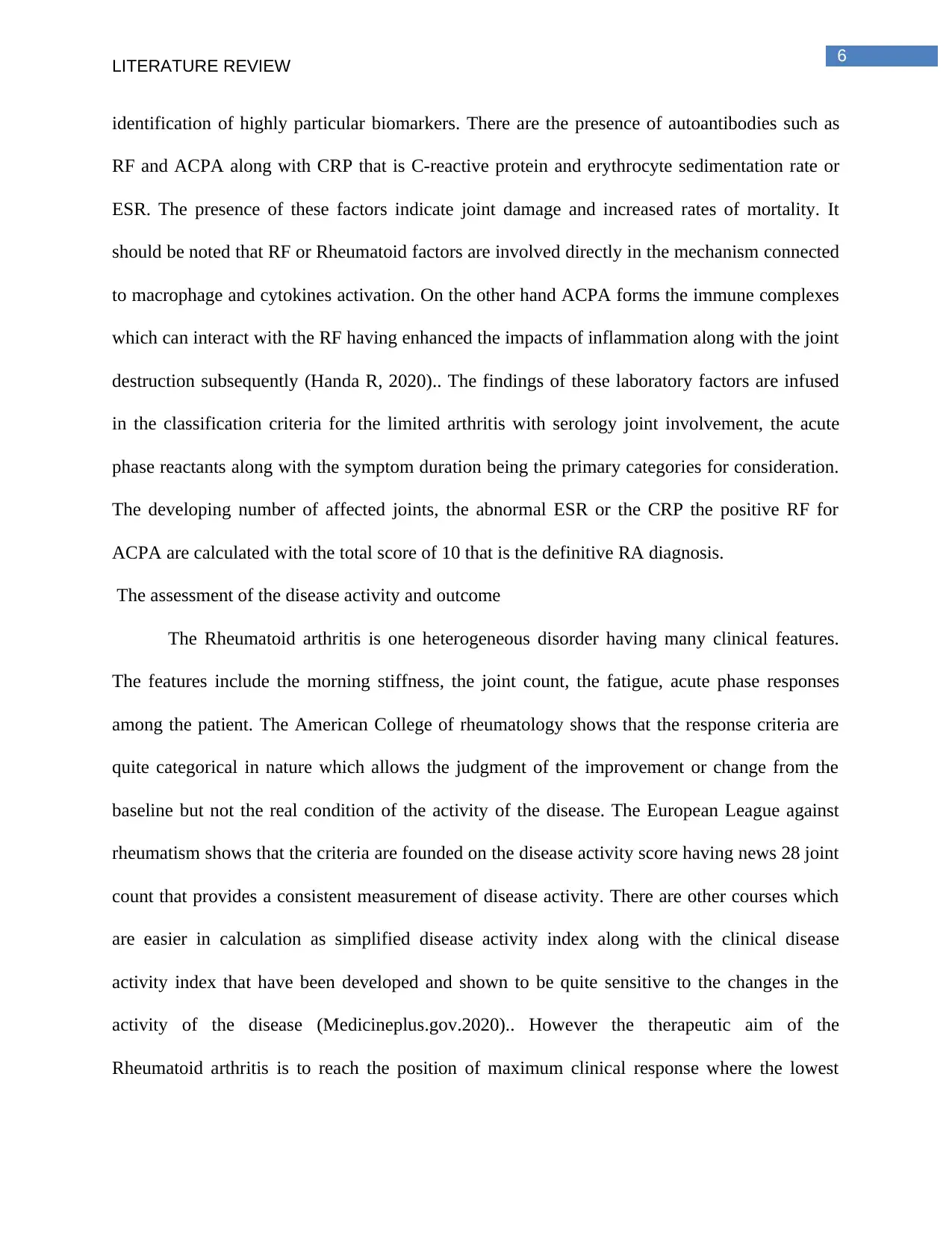
6
LITERATURE REVIEW
identification of highly particular biomarkers. There are the presence of autoantibodies such as
RF and ACPA along with CRP that is C-reactive protein and erythrocyte sedimentation rate or
ESR. The presence of these factors indicate joint damage and increased rates of mortality. It
should be noted that RF or Rheumatoid factors are involved directly in the mechanism connected
to macrophage and cytokines activation. On the other hand ACPA forms the immune complexes
which can interact with the RF having enhanced the impacts of inflammation along with the joint
destruction subsequently (Handa R, 2020).. The findings of these laboratory factors are infused
in the classification criteria for the limited arthritis with serology joint involvement, the acute
phase reactants along with the symptom duration being the primary categories for consideration.
The developing number of affected joints, the abnormal ESR or the CRP the positive RF for
ACPA are calculated with the total score of 10 that is the definitive RA diagnosis.
The assessment of the disease activity and outcome
The Rheumatoid arthritis is one heterogeneous disorder having many clinical features.
The features include the morning stiffness, the joint count, the fatigue, acute phase responses
among the patient. The American College of rheumatology shows that the response criteria are
quite categorical in nature which allows the judgment of the improvement or change from the
baseline but not the real condition of the activity of the disease. The European League against
rheumatism shows that the criteria are founded on the disease activity score having news 28 joint
count that provides a consistent measurement of disease activity. There are other courses which
are easier in calculation as simplified disease activity index along with the clinical disease
activity index that have been developed and shown to be quite sensitive to the changes in the
activity of the disease (Medicineplus.gov.2020).. However the therapeutic aim of the
Rheumatoid arthritis is to reach the position of maximum clinical response where the lowest
LITERATURE REVIEW
identification of highly particular biomarkers. There are the presence of autoantibodies such as
RF and ACPA along with CRP that is C-reactive protein and erythrocyte sedimentation rate or
ESR. The presence of these factors indicate joint damage and increased rates of mortality. It
should be noted that RF or Rheumatoid factors are involved directly in the mechanism connected
to macrophage and cytokines activation. On the other hand ACPA forms the immune complexes
which can interact with the RF having enhanced the impacts of inflammation along with the joint
destruction subsequently (Handa R, 2020).. The findings of these laboratory factors are infused
in the classification criteria for the limited arthritis with serology joint involvement, the acute
phase reactants along with the symptom duration being the primary categories for consideration.
The developing number of affected joints, the abnormal ESR or the CRP the positive RF for
ACPA are calculated with the total score of 10 that is the definitive RA diagnosis.
The assessment of the disease activity and outcome
The Rheumatoid arthritis is one heterogeneous disorder having many clinical features.
The features include the morning stiffness, the joint count, the fatigue, acute phase responses
among the patient. The American College of rheumatology shows that the response criteria are
quite categorical in nature which allows the judgment of the improvement or change from the
baseline but not the real condition of the activity of the disease. The European League against
rheumatism shows that the criteria are founded on the disease activity score having news 28 joint
count that provides a consistent measurement of disease activity. There are other courses which
are easier in calculation as simplified disease activity index along with the clinical disease
activity index that have been developed and shown to be quite sensitive to the changes in the
activity of the disease (Medicineplus.gov.2020).. However the therapeutic aim of the
Rheumatoid arthritis is to reach the position of maximum clinical response where the lowest
⊘ This is a preview!⊘
Do you want full access?
Subscribe today to unlock all pages.

Trusted by 1+ million students worldwide
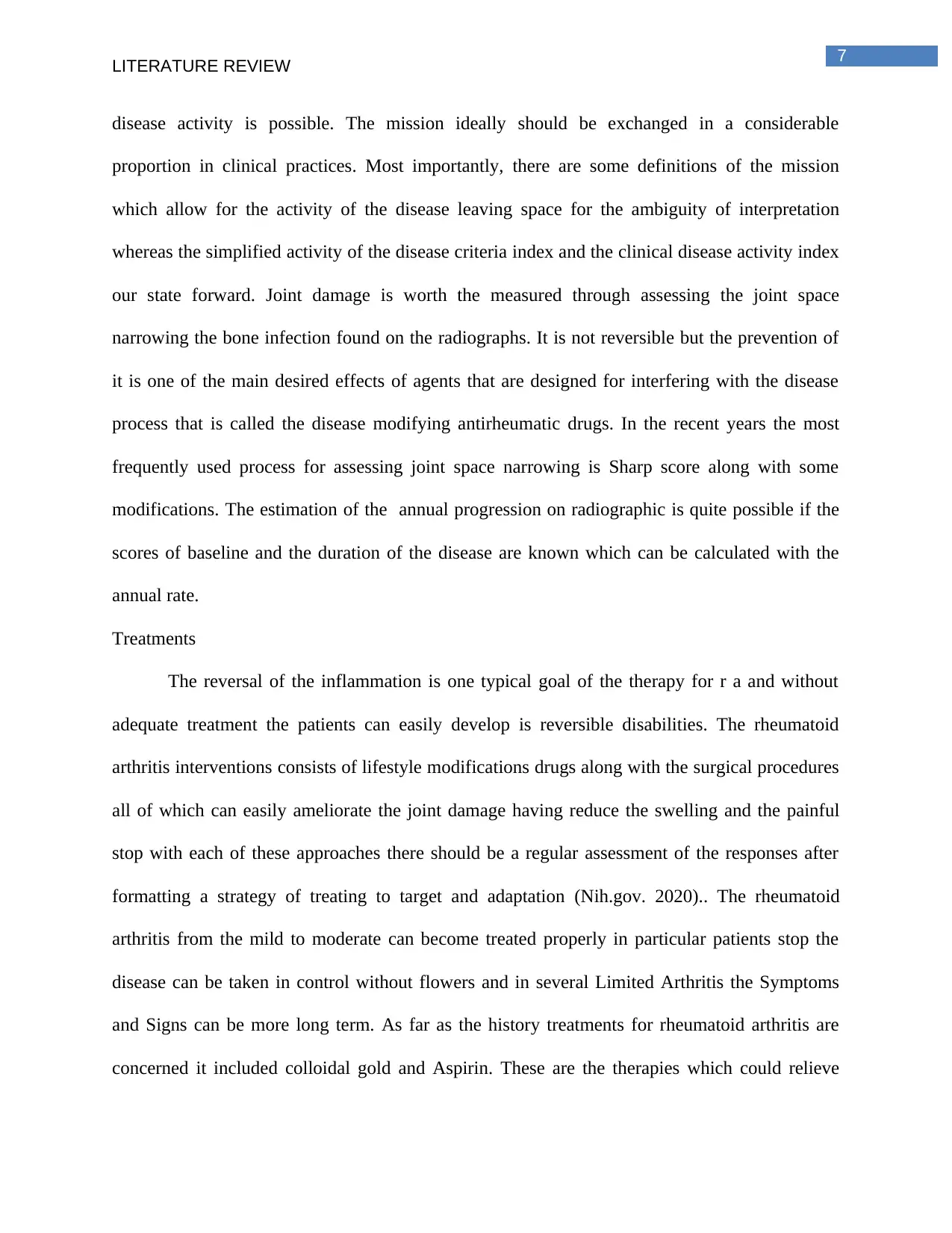
7
LITERATURE REVIEW
disease activity is possible. The mission ideally should be exchanged in a considerable
proportion in clinical practices. Most importantly, there are some definitions of the mission
which allow for the activity of the disease leaving space for the ambiguity of interpretation
whereas the simplified activity of the disease criteria index and the clinical disease activity index
our state forward. Joint damage is worth the measured through assessing the joint space
narrowing the bone infection found on the radiographs. It is not reversible but the prevention of
it is one of the main desired effects of agents that are designed for interfering with the disease
process that is called the disease modifying antirheumatic drugs. In the recent years the most
frequently used process for assessing joint space narrowing is Sharp score along with some
modifications. The estimation of the annual progression on radiographic is quite possible if the
scores of baseline and the duration of the disease are known which can be calculated with the
annual rate.
Treatments
The reversal of the inflammation is one typical goal of the therapy for r a and without
adequate treatment the patients can easily develop is reversible disabilities. The rheumatoid
arthritis interventions consists of lifestyle modifications drugs along with the surgical procedures
all of which can easily ameliorate the joint damage having reduce the swelling and the painful
stop with each of these approaches there should be a regular assessment of the responses after
formatting a strategy of treating to target and adaptation (Nih.gov. 2020).. The rheumatoid
arthritis from the mild to moderate can become treated properly in particular patients stop the
disease can be taken in control without flowers and in several Limited Arthritis the Symptoms
and Signs can be more long term. As far as the history treatments for rheumatoid arthritis are
concerned it included colloidal gold and Aspirin. These are the therapies which could relieve
LITERATURE REVIEW
disease activity is possible. The mission ideally should be exchanged in a considerable
proportion in clinical practices. Most importantly, there are some definitions of the mission
which allow for the activity of the disease leaving space for the ambiguity of interpretation
whereas the simplified activity of the disease criteria index and the clinical disease activity index
our state forward. Joint damage is worth the measured through assessing the joint space
narrowing the bone infection found on the radiographs. It is not reversible but the prevention of
it is one of the main desired effects of agents that are designed for interfering with the disease
process that is called the disease modifying antirheumatic drugs. In the recent years the most
frequently used process for assessing joint space narrowing is Sharp score along with some
modifications. The estimation of the annual progression on radiographic is quite possible if the
scores of baseline and the duration of the disease are known which can be calculated with the
annual rate.
Treatments
The reversal of the inflammation is one typical goal of the therapy for r a and without
adequate treatment the patients can easily develop is reversible disabilities. The rheumatoid
arthritis interventions consists of lifestyle modifications drugs along with the surgical procedures
all of which can easily ameliorate the joint damage having reduce the swelling and the painful
stop with each of these approaches there should be a regular assessment of the responses after
formatting a strategy of treating to target and adaptation (Nih.gov. 2020).. The rheumatoid
arthritis from the mild to moderate can become treated properly in particular patients stop the
disease can be taken in control without flowers and in several Limited Arthritis the Symptoms
and Signs can be more long term. As far as the history treatments for rheumatoid arthritis are
concerned it included colloidal gold and Aspirin. These are the therapies which could relieve
Paraphrase This Document
Need a fresh take? Get an instant paraphrase of this document with our AI Paraphraser
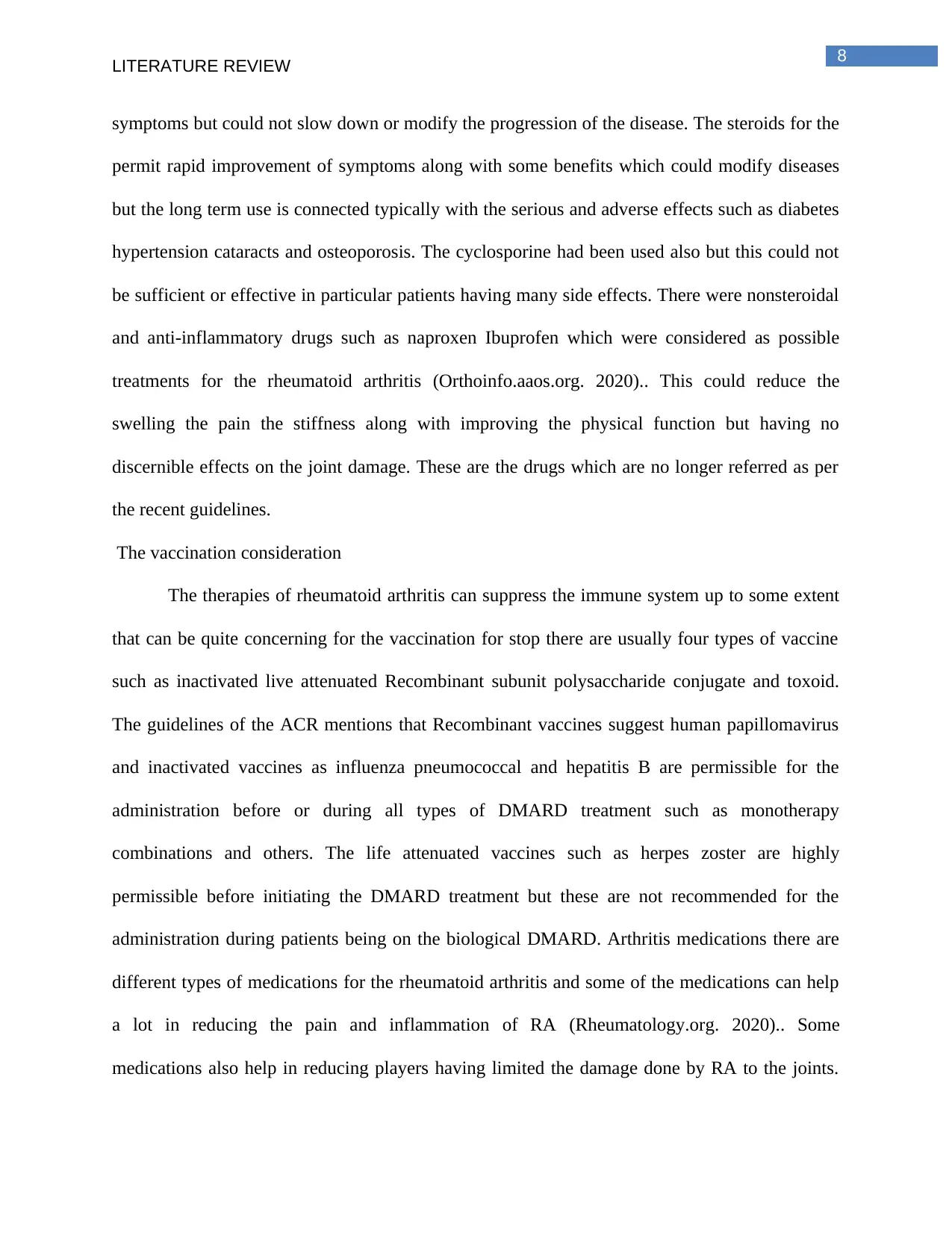
8
LITERATURE REVIEW
symptoms but could not slow down or modify the progression of the disease. The steroids for the
permit rapid improvement of symptoms along with some benefits which could modify diseases
but the long term use is connected typically with the serious and adverse effects such as diabetes
hypertension cataracts and osteoporosis. The cyclosporine had been used also but this could not
be sufficient or effective in particular patients having many side effects. There were nonsteroidal
and anti-inflammatory drugs such as naproxen Ibuprofen which were considered as possible
treatments for the rheumatoid arthritis (Orthoinfo.aaos.org. 2020).. This could reduce the
swelling the pain the stiffness along with improving the physical function but having no
discernible effects on the joint damage. These are the drugs which are no longer referred as per
the recent guidelines.
The vaccination consideration
The therapies of rheumatoid arthritis can suppress the immune system up to some extent
that can be quite concerning for the vaccination for stop there are usually four types of vaccine
such as inactivated live attenuated Recombinant subunit polysaccharide conjugate and toxoid.
The guidelines of the ACR mentions that Recombinant vaccines suggest human papillomavirus
and inactivated vaccines as influenza pneumococcal and hepatitis B are permissible for the
administration before or during all types of DMARD treatment such as monotherapy
combinations and others. The life attenuated vaccines such as herpes zoster are highly
permissible before initiating the DMARD treatment but these are not recommended for the
administration during patients being on the biological DMARD. Arthritis medications there are
different types of medications for the rheumatoid arthritis and some of the medications can help
a lot in reducing the pain and inflammation of RA (Rheumatology.org. 2020).. Some
medications also help in reducing players having limited the damage done by RA to the joints.
LITERATURE REVIEW
symptoms but could not slow down or modify the progression of the disease. The steroids for the
permit rapid improvement of symptoms along with some benefits which could modify diseases
but the long term use is connected typically with the serious and adverse effects such as diabetes
hypertension cataracts and osteoporosis. The cyclosporine had been used also but this could not
be sufficient or effective in particular patients having many side effects. There were nonsteroidal
and anti-inflammatory drugs such as naproxen Ibuprofen which were considered as possible
treatments for the rheumatoid arthritis (Orthoinfo.aaos.org. 2020).. This could reduce the
swelling the pain the stiffness along with improving the physical function but having no
discernible effects on the joint damage. These are the drugs which are no longer referred as per
the recent guidelines.
The vaccination consideration
The therapies of rheumatoid arthritis can suppress the immune system up to some extent
that can be quite concerning for the vaccination for stop there are usually four types of vaccine
such as inactivated live attenuated Recombinant subunit polysaccharide conjugate and toxoid.
The guidelines of the ACR mentions that Recombinant vaccines suggest human papillomavirus
and inactivated vaccines as influenza pneumococcal and hepatitis B are permissible for the
administration before or during all types of DMARD treatment such as monotherapy
combinations and others. The life attenuated vaccines such as herpes zoster are highly
permissible before initiating the DMARD treatment but these are not recommended for the
administration during patients being on the biological DMARD. Arthritis medications there are
different types of medications for the rheumatoid arthritis and some of the medications can help
a lot in reducing the pain and inflammation of RA (Rheumatology.org. 2020).. Some
medications also help in reducing players having limited the damage done by RA to the joints.
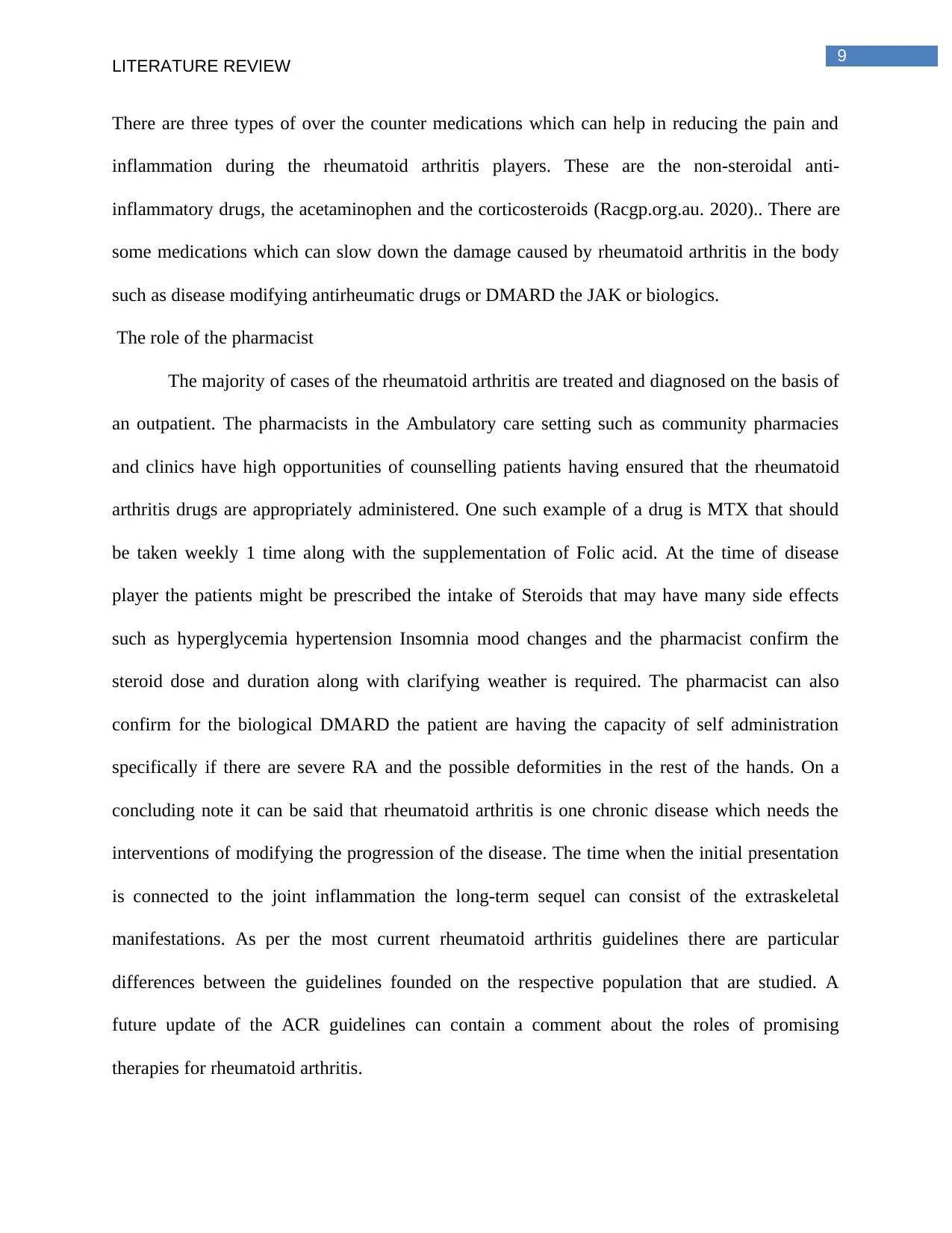
9
LITERATURE REVIEW
There are three types of over the counter medications which can help in reducing the pain and
inflammation during the rheumatoid arthritis players. These are the non-steroidal anti-
inflammatory drugs, the acetaminophen and the corticosteroids (Racgp.org.au. 2020).. There are
some medications which can slow down the damage caused by rheumatoid arthritis in the body
such as disease modifying antirheumatic drugs or DMARD the JAK or biologics.
The role of the pharmacist
The majority of cases of the rheumatoid arthritis are treated and diagnosed on the basis of
an outpatient. The pharmacists in the Ambulatory care setting such as community pharmacies
and clinics have high opportunities of counselling patients having ensured that the rheumatoid
arthritis drugs are appropriately administered. One such example of a drug is MTX that should
be taken weekly 1 time along with the supplementation of Folic acid. At the time of disease
player the patients might be prescribed the intake of Steroids that may have many side effects
such as hyperglycemia hypertension Insomnia mood changes and the pharmacist confirm the
steroid dose and duration along with clarifying weather is required. The pharmacist can also
confirm for the biological DMARD the patient are having the capacity of self administration
specifically if there are severe RA and the possible deformities in the rest of the hands. On a
concluding note it can be said that rheumatoid arthritis is one chronic disease which needs the
interventions of modifying the progression of the disease. The time when the initial presentation
is connected to the joint inflammation the long-term sequel can consist of the extraskeletal
manifestations. As per the most current rheumatoid arthritis guidelines there are particular
differences between the guidelines founded on the respective population that are studied. A
future update of the ACR guidelines can contain a comment about the roles of promising
therapies for rheumatoid arthritis.
LITERATURE REVIEW
There are three types of over the counter medications which can help in reducing the pain and
inflammation during the rheumatoid arthritis players. These are the non-steroidal anti-
inflammatory drugs, the acetaminophen and the corticosteroids (Racgp.org.au. 2020).. There are
some medications which can slow down the damage caused by rheumatoid arthritis in the body
such as disease modifying antirheumatic drugs or DMARD the JAK or biologics.
The role of the pharmacist
The majority of cases of the rheumatoid arthritis are treated and diagnosed on the basis of
an outpatient. The pharmacists in the Ambulatory care setting such as community pharmacies
and clinics have high opportunities of counselling patients having ensured that the rheumatoid
arthritis drugs are appropriately administered. One such example of a drug is MTX that should
be taken weekly 1 time along with the supplementation of Folic acid. At the time of disease
player the patients might be prescribed the intake of Steroids that may have many side effects
such as hyperglycemia hypertension Insomnia mood changes and the pharmacist confirm the
steroid dose and duration along with clarifying weather is required. The pharmacist can also
confirm for the biological DMARD the patient are having the capacity of self administration
specifically if there are severe RA and the possible deformities in the rest of the hands. On a
concluding note it can be said that rheumatoid arthritis is one chronic disease which needs the
interventions of modifying the progression of the disease. The time when the initial presentation
is connected to the joint inflammation the long-term sequel can consist of the extraskeletal
manifestations. As per the most current rheumatoid arthritis guidelines there are particular
differences between the guidelines founded on the respective population that are studied. A
future update of the ACR guidelines can contain a comment about the roles of promising
therapies for rheumatoid arthritis.
⊘ This is a preview!⊘
Do you want full access?
Subscribe today to unlock all pages.

Trusted by 1+ million students worldwide
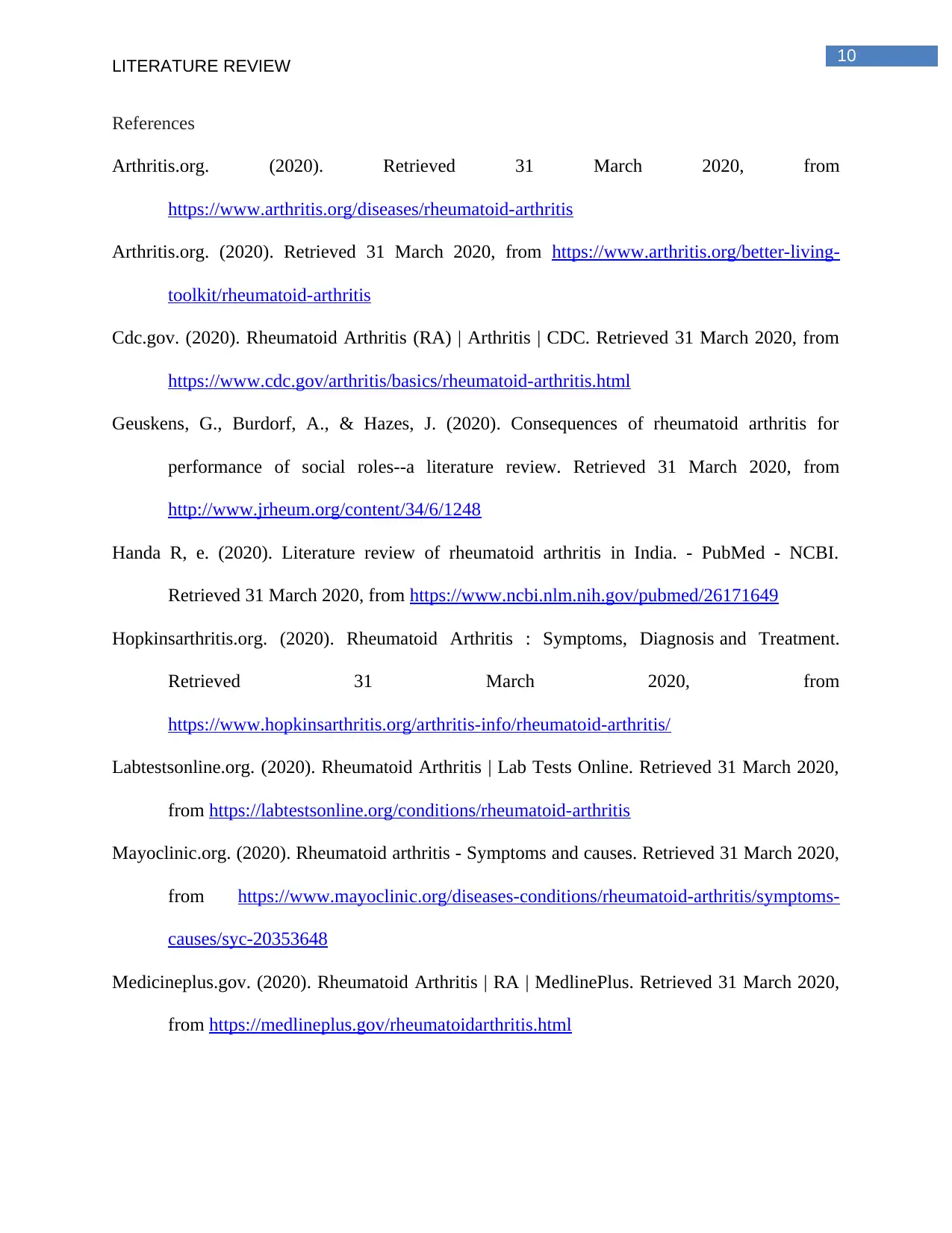
10
LITERATURE REVIEW
References
Arthritis.org. (2020). Retrieved 31 March 2020, from
https://www.arthritis.org/diseases/rheumatoid-arthritis
Arthritis.org. (2020). Retrieved 31 March 2020, from https://www.arthritis.org/better-living-
toolkit/rheumatoid-arthritis
Cdc.gov. (2020). Rheumatoid Arthritis (RA) | Arthritis | CDC. Retrieved 31 March 2020, from
https://www.cdc.gov/arthritis/basics/rheumatoid-arthritis.html
Geuskens, G., Burdorf, A., & Hazes, J. (2020). Consequences of rheumatoid arthritis for
performance of social roles--a literature review. Retrieved 31 March 2020, from
http://www.jrheum.org/content/34/6/1248
Handa R, e. (2020). Literature review of rheumatoid arthritis in India. - PubMed - NCBI.
Retrieved 31 March 2020, from https://www.ncbi.nlm.nih.gov/pubmed/26171649
Hopkinsarthritis.org. (2020). Rheumatoid Arthritis : Symptoms, Diagnosis and Treatment.
Retrieved 31 March 2020, from
https://www.hopkinsarthritis.org/arthritis-info/rheumatoid-arthritis/
Labtestsonline.org. (2020). Rheumatoid Arthritis | Lab Tests Online. Retrieved 31 March 2020,
from https://labtestsonline.org/conditions/rheumatoid-arthritis
Mayoclinic.org. (2020). Rheumatoid arthritis - Symptoms and causes. Retrieved 31 March 2020,
from https://www.mayoclinic.org/diseases-conditions/rheumatoid-arthritis/symptoms-
causes/syc-20353648
Medicineplus.gov. (2020). Rheumatoid Arthritis | RA | MedlinePlus. Retrieved 31 March 2020,
from https://medlineplus.gov/rheumatoidarthritis.html
LITERATURE REVIEW
References
Arthritis.org. (2020). Retrieved 31 March 2020, from
https://www.arthritis.org/diseases/rheumatoid-arthritis
Arthritis.org. (2020). Retrieved 31 March 2020, from https://www.arthritis.org/better-living-
toolkit/rheumatoid-arthritis
Cdc.gov. (2020). Rheumatoid Arthritis (RA) | Arthritis | CDC. Retrieved 31 March 2020, from
https://www.cdc.gov/arthritis/basics/rheumatoid-arthritis.html
Geuskens, G., Burdorf, A., & Hazes, J. (2020). Consequences of rheumatoid arthritis for
performance of social roles--a literature review. Retrieved 31 March 2020, from
http://www.jrheum.org/content/34/6/1248
Handa R, e. (2020). Literature review of rheumatoid arthritis in India. - PubMed - NCBI.
Retrieved 31 March 2020, from https://www.ncbi.nlm.nih.gov/pubmed/26171649
Hopkinsarthritis.org. (2020). Rheumatoid Arthritis : Symptoms, Diagnosis and Treatment.
Retrieved 31 March 2020, from
https://www.hopkinsarthritis.org/arthritis-info/rheumatoid-arthritis/
Labtestsonline.org. (2020). Rheumatoid Arthritis | Lab Tests Online. Retrieved 31 March 2020,
from https://labtestsonline.org/conditions/rheumatoid-arthritis
Mayoclinic.org. (2020). Rheumatoid arthritis - Symptoms and causes. Retrieved 31 March 2020,
from https://www.mayoclinic.org/diseases-conditions/rheumatoid-arthritis/symptoms-
causes/syc-20353648
Medicineplus.gov. (2020). Rheumatoid Arthritis | RA | MedlinePlus. Retrieved 31 March 2020,
from https://medlineplus.gov/rheumatoidarthritis.html
Paraphrase This Document
Need a fresh take? Get an instant paraphrase of this document with our AI Paraphraser
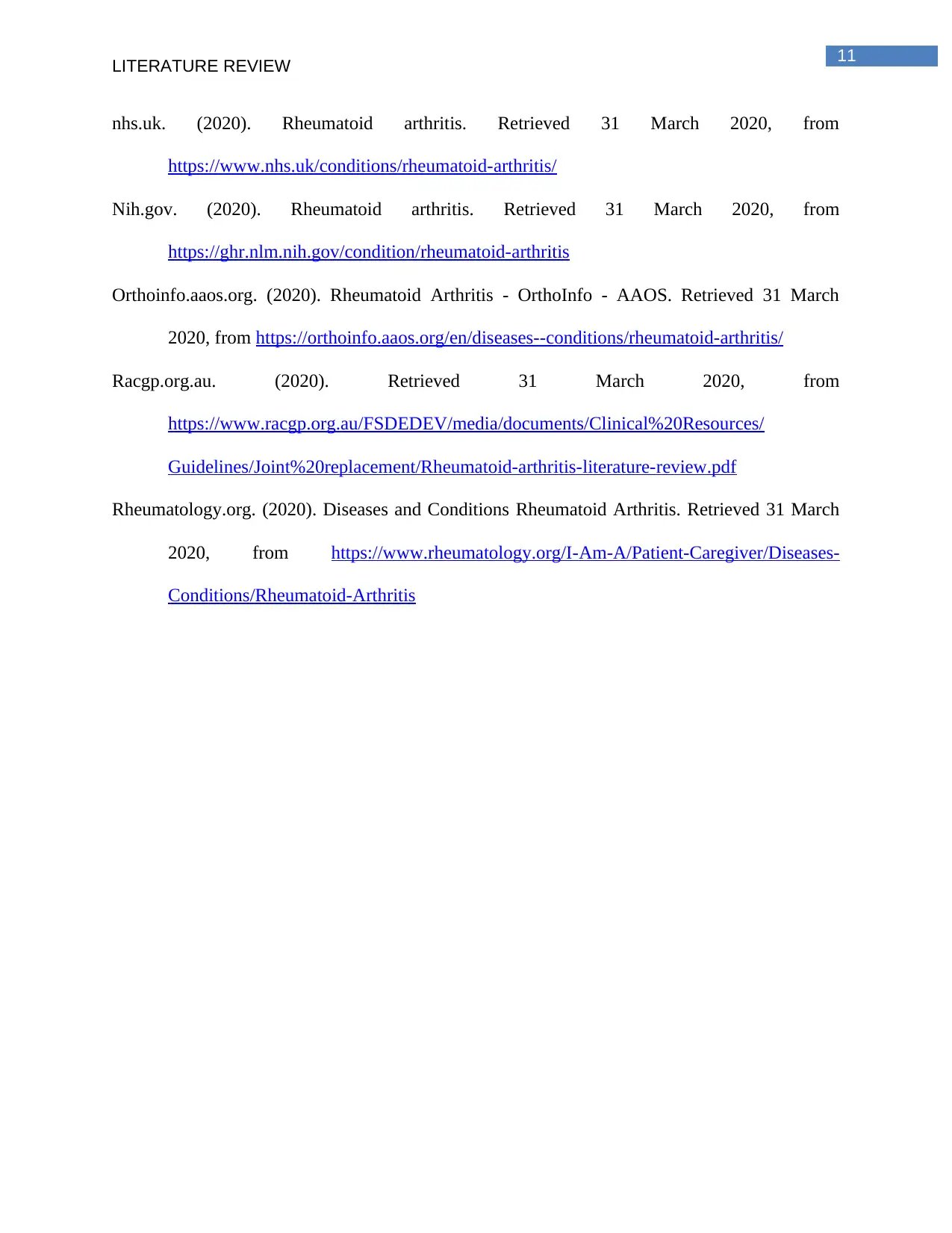
11
LITERATURE REVIEW
nhs.uk. (2020). Rheumatoid arthritis. Retrieved 31 March 2020, from
https://www.nhs.uk/conditions/rheumatoid-arthritis/
Nih.gov. (2020). Rheumatoid arthritis. Retrieved 31 March 2020, from
https://ghr.nlm.nih.gov/condition/rheumatoid-arthritis
Orthoinfo.aaos.org. (2020). Rheumatoid Arthritis - OrthoInfo - AAOS. Retrieved 31 March
2020, from https://orthoinfo.aaos.org/en/diseases--conditions/rheumatoid-arthritis/
Racgp.org.au. (2020). Retrieved 31 March 2020, from
https://www.racgp.org.au/FSDEDEV/media/documents/Clinical%20Resources/
Guidelines/Joint%20replacement/Rheumatoid-arthritis-literature-review.pdf
Rheumatology.org. (2020). Diseases and Conditions Rheumatoid Arthritis. Retrieved 31 March
2020, from https://www.rheumatology.org/I-Am-A/Patient-Caregiver/Diseases-
Conditions/Rheumatoid-Arthritis
LITERATURE REVIEW
nhs.uk. (2020). Rheumatoid arthritis. Retrieved 31 March 2020, from
https://www.nhs.uk/conditions/rheumatoid-arthritis/
Nih.gov. (2020). Rheumatoid arthritis. Retrieved 31 March 2020, from
https://ghr.nlm.nih.gov/condition/rheumatoid-arthritis
Orthoinfo.aaos.org. (2020). Rheumatoid Arthritis - OrthoInfo - AAOS. Retrieved 31 March
2020, from https://orthoinfo.aaos.org/en/diseases--conditions/rheumatoid-arthritis/
Racgp.org.au. (2020). Retrieved 31 March 2020, from
https://www.racgp.org.au/FSDEDEV/media/documents/Clinical%20Resources/
Guidelines/Joint%20replacement/Rheumatoid-arthritis-literature-review.pdf
Rheumatology.org. (2020). Diseases and Conditions Rheumatoid Arthritis. Retrieved 31 March
2020, from https://www.rheumatology.org/I-Am-A/Patient-Caregiver/Diseases-
Conditions/Rheumatoid-Arthritis
1 out of 11
Related Documents
Your All-in-One AI-Powered Toolkit for Academic Success.
+13062052269
info@desklib.com
Available 24*7 on WhatsApp / Email
![[object Object]](/_next/static/media/star-bottom.7253800d.svg)
Unlock your academic potential
Copyright © 2020–2025 A2Z Services. All Rights Reserved. Developed and managed by ZUCOL.





